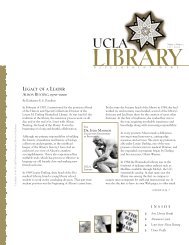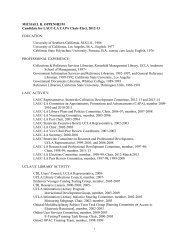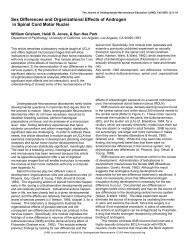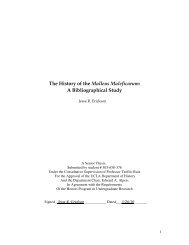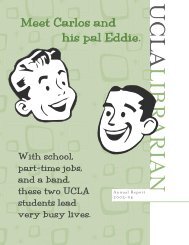Research Paper - UCLA Library
Research Paper - UCLA Library
Research Paper - UCLA Library
Create successful ePaper yourself
Turn your PDF publications into a flip-book with our unique Google optimized e-Paper software.
staged allegory of the monarch accepted the results of the Reformation from Truth, Elizabeth<br />
Gu 11<br />
allows herself to become allegorized as well, elevating her to the level of the symbolic. From the<br />
beginning, Elizabeth was aware of the benefits of using her body to perform a symbolic religious<br />
message.<br />
However, the Elizabethan attempts at image promotion could only go so far. The years<br />
went by, the Queen aged, and yet newer portraits continued to present the monarch as if she were<br />
a young supple girl of sixteen years; “as her country became weary, and a shade cynical about<br />
her posturing, the image promotion became more strenuous” (Loades 93). In Elizabeth’s final<br />
years, the Elizabethan iconography experienced what Strong terms as the “portrait crisis of the<br />
1590s, namely the reconciliation of idea and reality in portraying a fast-ageing queen” (Strong,<br />
Gloriana 140).<br />
III. A CHILDLESS QUEEN: THE TENSIONS OF THE 1590S<br />
Elizabeth was not always perceived (and praised) as the virgin queen. 5 King argues that<br />
even the celebration of Elizabeth’s virginity did not take its final form until after 1583. The<br />
English people had always assumed that the queen would eventually marry until the 1579-1583<br />
marriage negotiations with her last suitor, François, duc Alençon, had failed 6 (King, “Queen<br />
Elizabeth I” 32). In fact, Parliament, both the Lords and the Commons, had repeatedly petitioned<br />
the Queen to marry throughout the 1560s and 70s (Loades 40). It was only after Elizabeth<br />
became too old to bear children that praise of the queen began to shift to that of Elizabeth as the<br />
virgin goddess Diana.<br />
5 Although drama is not specifically discussed, the essays in Julia M. Walker’s Dissing Elizabeth: Negative<br />
Representations of Gloriana may form a useful background for the subversive discourse of discontent and dissent<br />
from Elizabeth’s days as a princess through the 1620s.<br />
6 However, support for François was significantly less than those for her previous two suitors, Charles of Austria<br />
and Henri, duc Anjon (incidentally François’s older brother). By the time of this third negotiation, many believed<br />
that the Queen was “past childbearing, and would be compromising herself and her realm for nothing” (Loades 54).



